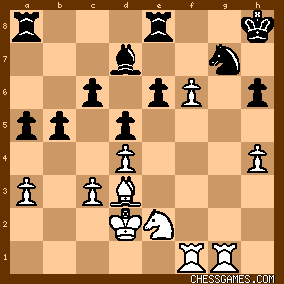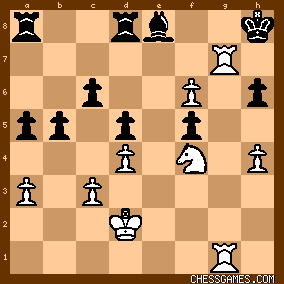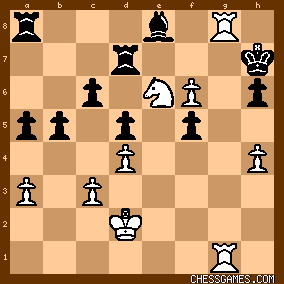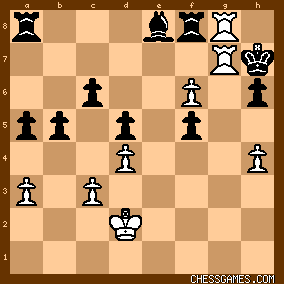| Dec-22-03 | | fatbaldguy: To follow up on the previous post - black can try to save the bishop and prevent mate on g6 by playing Red8 30 Nf4 Be8, but after 31 Rfg1 the threat becomes 32 Rg8+ Kg8 32 R1g7 mate. Note that Petrosian saw way in advance (among other things) that black cannot play 31 ... Bh5 to prevent both the rook mate and the Ng6 mate, since the h5 square is covered by the knight on f4.
Petrosian was known as a "dull" positional player, but as this game shows, you don't get to that level without having pretty good tactical skills as well. |
|
| Mar-16-04 | | Troewa: Also, after 29. Rg7 Red8 30. Nf4 Be8 31 Rfg1 Rd7 32 Rg8+ Kh7 33. Ne6 would seal the win with the direct mating threat of Nf8#, which can only be averted at the cost of heavy material loss. Nice attack by Petrosian. |
|
| Jun-09-04 | | babakova: This game is hardly a tactical melee.. I would rather say that black is gradually pushed off the board |
|
Nov-23-06
 | | LIFE Master AJ: The game score here is wrong.
See game eight of "The Most Instructive Games of Chess Ever Played." (By I. Chernev.) |
|
| May-11-09 | | ToTheDeath: Remarkable game. It's no exaggeration to say <15...Nh5?> may already be the losing move- the knight never gets back into the game. Instead 15...dxe4! 16.fxe4 Ng4 looks necessary, with some counterplay. |
|
| Nov-17-09 | | badenbaden: Chessgames, the surname of black it's Corral. Kozali it`s a error of Chernev. |
|
| Feb-02-10 | | notyetagm: It is actually *Black* to move in the following position, but pretend it is White's move. 25 ?

click for larger viewWhat is threat?
The threat is 25 e5-e6!.
25 e5-e6!

click for larger viewBut wait. Doesn't the e6-square have two attackers (White e5-,f5-pawns) versus four(!) count'em four defenders (Black f7-pawn,g7-knight,d7-bishop,e8-rook)? And isn't the Black f7-pawn the *first* defender to boot? All true, but consider what happens after the obvious 25 ... f7xe6. 25 ... f7xe6 <self-block: e6>

click for larger view<After 25 ... f7xe6, the Black g7-knight no longer has any <FLIGHT SQUARES>! The Black e6-pawn now <SELF-BLOCKS> the e6-square, denying it to the Black g7-knight.> White now wins a piece with the simple pawn push 26 f5-f6 as the Black g7-knight has nowhere to run!!! 26 f5-f6 Δ f6x♘g7

click for larger viewSo, in the original diagram (which really is Black to play) White is threatening 25 e5-e6!. <COUNTING> does *not* apply as Black will have a <MISPLACED PIECE> (<TRAPPED> Black g7-knight) in the resulting position that White can exploit (26 f5-f6). <YOU CAN PUT *ANY* PIECE> (White e5-pawn) <ON *ANY* SQUARE> (e6-square, 25 e5-e6!) <NO MATTER WHAT COUNTING SAYS> (two attackers, 4(!) defenders) <IF THE OPPONENT WILL HAVE MISPLACED PIECES> (Black g7-knight, trapped) <IN THE *RESULTING* POSITION> <*AND* YOU CAN *EXPLOIT* THE MISPLACEMENT> (26 f5-f6, 27 f6xNg7). <CHESS IS <<<*NOT*>>> JUST COUNTING: MISPLACED PIECES <<<*SUSPEND*>>> THE NORMAL RULES OF COUNTING> <IF YOU PUT A PIECE ON A SQUARE, DOES THE OPPONENT HAVE PIECES THAT WILL *NOT* BE SAFE? YES. CAN YOU EXPLOIT THIS? YES.
THEN YOU CAN PUT THAT PIECE ON THAT SQUARE, <<<*REGARDLESS* OF WHAT COUNTING SAYS!!>>>> |
|
| Aug-06-12 | | backrank: Until the 25th move, the game proceeds rather straightforwardly, being typical Petrosian only inasmuch as he doesn't castle. However, it's remarkable that he attains such a positional superiority by making 'obvious' moves only. And then, as Fischer said, tactics flows from a positionally superior game, the position is already ripe: 26 e6! (wow)

click for larger viewAfter 26 ... fxe6 27 f6! (the point) the situatiion is similar to that describe above by <notyetagm>, only that the Ng7 now has two flight squares (the white pawn g4 has disappeared), both of them not being of much use: 
click for larger viewAfter 27 ... Nh5 28 Bg6 is the killer, while 27 ... Nf5 28 Bxf5 (liquidation of the defender) exf5 29 Rg7 is the game continuation: 
click for larger viewAt this point, Black had enough. His bishop is attacked, and either he thought that after defending him, 30 Nf4 would create an unstoppable mating threat (Chernev seemed to think so, too), or he really saw the whole line given by <fatbaldguy> and <Troewa> above: 29 ... Red8 30 Nf4 Be8 (for now, mate is stopped) 31 Rfg1 
click for larger viewNow mate in 2 is threatened, and the square g8 cannot be covered (Bd7 Ng6#, and on other B moves the B is captured), while 31 ... h5 leads to a mate in 3 (Rg8+, R1g7+, Rh8# thanks to kind support of the f-pawn), so that 31 ... Rd7 is forced, but then 32 Rg8+ Kg7 33 Ne6 settles it: 
click for larger viewNow Nf8# is threatened, and bishop moves lose the Ra8 (except 33 ... Bf7 34 R1g7#), while 33 ... h5 just delays mate (34 Nf8+ Kh6 35 Rh8+ Rh7 36 Rxh7#), so that 33 ... Rf7 seems the only defence, but then 34 Nf8+ Rxf8 35 R1g7# is a due finish to the game. 
click for larger view |
|
| Aug-06-12 | | backrank: Checking the above analysis with Rybka, I've found out that after 30 ... Be8, instead of 31 Rfg1, 31 Re1! is slightly simpler and more logical:
click for larger viewNow Rxe8+! is threatened to enable Ng6#, and Black can delay mate only by giving up his bishop. BTW, Rybka prefers 29 Rg6 to Petrosian's 29 Rg7, and after Rg7 Rybka recommends Rf8, surrendering the bishop at once (which is the best chance if Black wants to play on, but he didn't want so anyway). On playing through the whole game again, Petrosian's play doesn't seem so straightforward to me any more. 13 bxc3 is a bit surprising: while it strenghtens the center, it renders the a3 pawn somewhat weak. It never becomes an issue in the game, but you will have to feel that before making such a move (I myself would have felt uncomfortable). And then that advance 15 e4 in the center with the white king still lingering in the e-file! But it's the logical consequence of f3, and otherwise he will always have problems with guarding the backward pawn e3. Petrosian must have judged the position correctly already when he played 12 f3.
And then, concerning moves 21 and 22, the positioning of the rooks on files g and f is not so obvious. Maybe for Petrosian it is, but not for me (I always put them on the wrong files, as I realize only later in the game). |
|
| Feb-04-18 | | Grandma Sturleigh: Black needed to play 13...c5. After 13...Bd6 it's all one-way traffic. |
|
Oct-03-21
 | | kingscrusher: Very instructive game - and also when analysing such games, Chernev in the "Most instructive games of chess ever played" does this kind of game very nicely with minimal variations - reflecting the style perhaps of Petrosian's thinking himself, as opposed to potentially a complicated modern mess of a game. |
|
| Feb-04-23 | | generror: <<badenbaden:> Chessgames, the surname of black it's Corral. Kozali it`s a error of Chernev.> Whaaaat, an error of Chernev!?!?? XD
Max Euwe also calls him Kozali in his 1968 <The Development of Chess Style> (although his book seems very ghost-written to me, which is about the only stain on Euwe's integrity vest). But anyway and once more, hooray to <CG> to care for quality! |
|
| Jan-31-24 | | Shamot: Where is the gunfight?! I don't see any gunfight. Is there any gunfight? No, there is no gunfight. It is all OK. |
|
| Jan-31-24 | | Cecco: I have admiration for 17. Qd2. If I have the white pieces and want to try to win the game, the last thing that comes to my mind is to propose a queen trade. Instead the engine confirms that it is the best move. |
|
| Jan-31-24 | | goodevans: <Shamot> 🤣🤣🤣! |
|
| Jan-31-24 | | phantasmagorium: Chess is not supposed to be this easy.
Oh, wait, it only looks easy. I would not have thought of quite a number of the moves by both sides, most obviously 17. Qd2. |
|
| Jun-02-25 | | ewan14: Exchanging off the queen's in order to start an attack |
|
|
|
|





